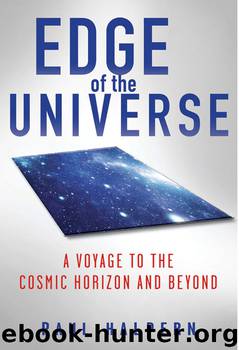Edge of the Universe by Paul Halpern

Author:Paul Halpern
Language: eng
Format: epub
ISBN: 9781118234600
Publisher: John Wiley & Sons, Ltd.
Published: 2012-08-02T16:00:00+00:00
Fickle-Flavored Neutrinos
The standard model of particle physics that emerged from the successes of electroweak theory (not to be confused with the standard model of cosmology that deals with the universe itself) treats neutrinos as if they were completely massless. If that were the case they could not be gravitational sources. Massless particles cannot tug on ordinary material through their gravitational influence. Dark matter particles must have at least some mass, therefore, to perform their star-steering feats.
However, as Italian theorist Bruno Pontecorvo first conjectured, if neutrinos are able to transform from one flavor to another (which they can, in a process called neutrino oscillation), they must possess at least some mass. Given neutrinos’ abundance in space, any mass they carried would add up to a hefty, but hard to detect, contribution to the material content of the universe.
Pontecorvo’s life journey had many twists and turns. Born in Pisa to a Jewish family, he traveled to Rome in 1934 to work with Enrico Fermi. When the Fascist government ruling Italy at the time passed anti-Semitic laws, Pontecorvo fled to France. He went on to live in the United States and Canada, where he became involved in classified atomic projects during the Second World War. He continued his nuclear research at the Atomic Energy Research Establishment in Harwell near Oxford, England. Alarming the UK and other Western governments, he defected to the Soviet Union in 1950. Later in life he asserted that he had made the foolish choice to believe that the ideology of the Soviet government was scientifically based and would lead to a utopian society. He regretted being naive in his political judgment.
No one would dispute Pontecorvo’s good judgment in the area of physics, however. A growing body of experimental evidence supports his neutrino oscillation hypothesis. In 1998, an international team of scientists from the Super-Kamiokande (Super-K) experiment based in Japan announced differences between the quantities of upward- and downward-moving muon neutrinos detected in an underground apparatus. While the upward-moving particles passed through almost the entire Earth on the way to the detector, the downward-moving particles arrived more directly from the atmosphere. The team found fewer upward-moving muon neutrinos, corresponding to theoretical predictions that a certain fraction had transformed on the way to the detector.
Not too far from where Pontecorvo once studied, a highway winds from Rome to the Adriatic coast, where sailing and other aquatic activities are popular summer pursuits. Tourists returning to the Eternal City along Highway A24 must pass through a tunnel beneath Gran Sasso, the tallest set of peaks in the Apennines. Deep within this underground passage, some may notice a special exit for a physics laboratory and wonder why a scientific facility would be in a highway tunnel. If there is a heavy traffic jam, scientists trying to leave the lab for home might be wondering the same thing.
Subterranean laboratories are ideal for neutrino detection. Thick layers of rock serve as perfect shields to block other types of particles that can’t penetrate as deeply. Most such
Download
This site does not store any files on its server. We only index and link to content provided by other sites. Please contact the content providers to delete copyright contents if any and email us, we'll remove relevant links or contents immediately.
| Aeronautics & Astronautics | Astronomy |
| Astrophysics & Space Science | Comets, Meteors & Asteroids |
| Cosmology | Mars |
| Solar System | Star-Gazing |
| Telescopes | UFOs |
Tools of Titans by Timothy Ferriss(8218)
Turbulence by E. J. Noyes(7936)
Secrets of Antigravity Propulsion: Tesla, UFOs, and Classified Aerospace Technology by Ph.D. Paul A. Laviolette(5309)
Astrophysics for People in a Hurry by Neil DeGrasse Tyson(5133)
Room 212 by Kate Stewart(5037)
Design of Trajectory Optimization Approach for Space Maneuver Vehicle Skip Entry Problems by Runqi Chai & Al Savvaris & Antonios Tsourdos & Senchun Chai(5011)
Pale Blue Dot by Carl Sagan(4912)
The David Icke Guide to the Global Conspiracy (and how to end it) by David Icke(4625)
A Journey Through Divination and Astronomy by Publishing Pottermore(4344)
Goodbye Paradise(3727)
Apollo 8 by Jeffrey Kluger(3637)
COSMOS by Carl Sagan(3554)
Losing the Nobel Prize by Brian Keating(3499)
The Five People You Meet in Heaven by Mitch Albom(3475)
How to Read Water: Clues and Patterns from Puddles to the Sea (Natural Navigation) by Tristan Gooley(3409)
Brief Answers to the Big Questions by Stephen Hawking(3369)
How to Read Nature by Tristan Gooley(3249)
The Order of Time by Carlo Rovelli(3145)
A Brief History of Time by Stephen Hawking(2961)
